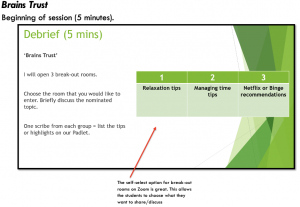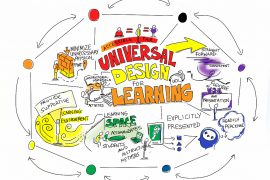Phillip Poulton and Rachel Yoo are PhD candidates and tutors in the Sydney School of Education and Social Work, and also qualified primary school teachers with years of experience in the classroom between them. The challenges for teaching and learning since the start of the pandemic, especially the periods of online-only learning, also provided opportunities for Rachel and Phillip to re-think their identities as teachers, and develop well-being activities for tutorials to share with their school – and now with all of us.
Leanne Stevenson: There’s usually so much to get through in a tutorial, but you’ve both re-thought this when teaching online, and centred a different approach. Can you tell me about this?
Phillip Poulton: It started with the question of how do you build relationships in the online space and how do you take time for well-being online? Going in content-heavy straightaway in tutorials, you’re never building relationships, and you’re dismissing students’ well-being from the word go. Without even getting to know them. I work from the idea that people need to start talking and discussing, relations are constructed through these interactions, and my particular task is how do I get people talking about something in common.
Talking with other colleagues, we realised what we were seeing separately is widespread. The number of emails that we were getting was increasing because people were seeking some sort of contact with us, and I think that urged us to go ‘yep it’s okay to focus less on the content, to spend some time every class socialising‘. But I’d also challenge teachers to switch that mindset a little bit; content doesn’t have to be fixed and static, you can think more flexibly about the content and find room to manoeuvre in your tutorial or lesson plan so that opportunities to connect with students are prioritised. You do actually have wiggle room as the tutor, so use the wiggle room. Don’t buy into the whole narrative ‘the lesson plan says this’. We might not get to it until next week, or the students are at a stage where those outcomes will be met later on.

Rachel Yoo: My teaching philosophy has always been underpinned by an ethic of care. Demonstrating and embedding care has always been at the centre of my teaching. However, with the sudden shift to online learning and changing needs of students (in terms of their learning and emotional well-being), I’ve found that ‘enacting care’ has ultimately extended to engaging in ‘intentional teaching practice’. In effect, I’ve become much more critical of how I design and organise my tutorial activities, as well as determining what teaching strategies would work best to support and/or even enhance students’ learning experiences.
I still clearly remember the first, I think, few weeks of teaching in 2020, we sat down and thought through what are some engaging activities that we could run with the students. For us, it was exciting at that point as well because we were just thrown into this space of having to teach online and therefore had the opportunity to explore the diverse affordances of the ‘online learning space’.
Leanne: There’s a cringe thing about icebreaker activities, I think even tutors might groan about having to do them, “This is going to be awkward for everybody“. How did you get the students on board?
Rachel: I was predominantly teaching first-years and I think they’re going to be excited for these sorts of activities, perhaps with 3rd or 4th years it could be a bit of a different story, but I think, for the most part of online learning, students really did appreciate us including these ice-breaker activities.

Phil: I taught Masters. Some of them actually like it! The tutor has to sell it really, it is about really encouraging students to participate, and if you come in energetically, not double guessing it, the students might think ‘okay, let’s give this a try’. And maybe because they hadn’t seen so many people for so long the opportunity to do something silly like join a puzzle together was actually quite cool.
Phil: Really, it’s around having non-threatening conversations or non-threatening moments, i.e., don’t start immediately with ‘we have to talk about a reading’, or ‘we have to talk about content’. Let’s talk about something silly, or can you join this puzzle together, or just talk about a memory from when we used to go on campus and what was that like, and it generally got people talking.
Rachel: Also, both Phil and I devoted time to running these ‘engagement booster activities’ in every tutorial from the start to the end of the semester. For me personally, it was important for students to understand that the purpose of these activities was to establish an open classroom culture focused on community building, rather than, the activities functioning as a ‘one-off, fun’ opportunity to interact with their peers and tutor.
Ensuring that a sense of community was maintained across all my lessons was particularly imperative, given the diverse cohort of students I was teaching (i.e. students joining class from overseas and students for whom English wasn’t their first or home language).
When planning my “engagement booster activities” I also considered the need to implement a staggered design approach. For example, towards the beginning of the semester – with students just getting to know their peers, I organised and ran ice-breaker type activities to encourage initial conversations to flow (e.g. ‘Introductory Bingo’). As the semester progressed, I would run activities that involved students developing deeper and more intimate connections with their peers (e.g. ‘Snap Share’ – an activity requiring students to share and discuss a memorable or significant photo in their phone gallery in pairs, small groups, or as a whole class).
With respect to creating a culturally inclusive learning environment for students from diverse language backgrounds, one suggestion would be to gauge their interests – whether that’d be around hobbies or specific topics/subjects and identify ways to integrate these into the design of your lesson activities. For example, after discovering that many of my international students enjoyed listening to K-Pop, I made sure to include some well-known K-pop songs in a ‘Guess That Tune’ activity.
Phil: If activities have a really nice clear structure, then it’ll go quite well. Sometimes the problem is that we just say ‘yeah, we’ll put you in a breakout room for two minutes and just chat’.
If you’ve got a structure that students can use to engage in conversation with a new peer, you don’t end up having the scenario where students are just saying hi and then switching to mute.
I think that you can experiment with different structured activities as the semester progresses. For example, dropping into some of the break-out rooms early on and hearing students share their interests might help you develop future conversational prompts that relate back to these interests. I would also say that it is important to keep these activities consistent throughout the semester, almost to the point where your students expect them and feel comfortable with conversing on different, relaxed topics each week.
To help get you started with your own“engagement booster activities”, Rachel and Phillip have shared some of the resources they use in their classes:
- Download Where’s Waldo? images and have students work in small groups to find Waldo.
- Share this Random Question Generator link with students and ask them to answer three questions in small groups.
- Create your own jigsaws and crosswords using images or words relevant to your class, the university, or other interests the class has shared with you.
- Share this Random Picture Generator and have students share their thoughts about the image with each other.
- Use Note.ly or Padlet to collect ideas and thoughts.
- Use the Dept. of Education Check-in template to do brief anonymous check-ins with students at the end of class.






1 Comment